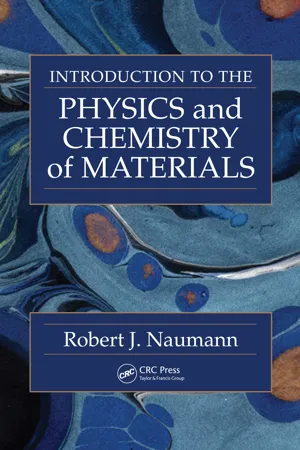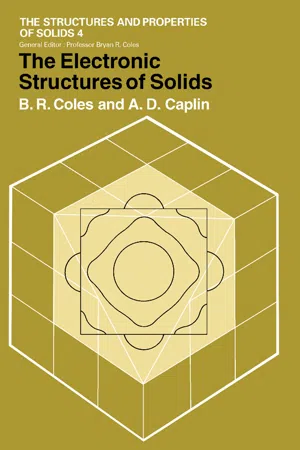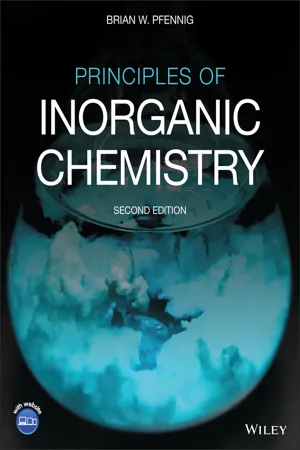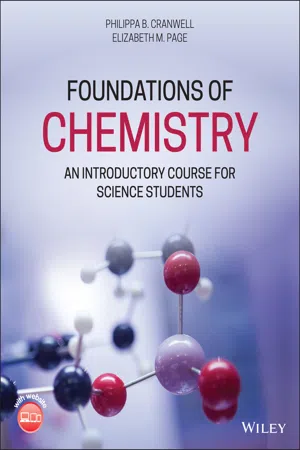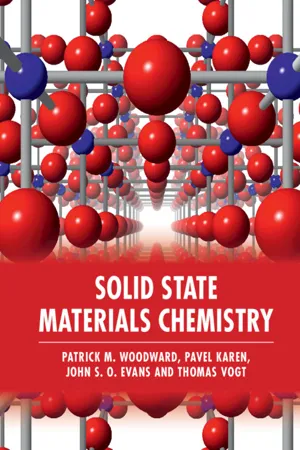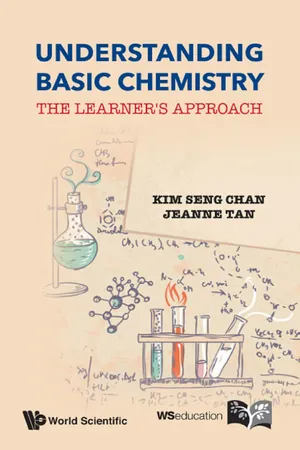Chemistry
Bonding
Bonding refers to the attractive forces that hold atoms together in a molecule or compound. These forces can be ionic, covalent, or metallic, depending on the sharing or transfer of electrons between atoms. Bonding is essential for determining the physical and chemical properties of substances and plays a crucial role in understanding the behavior of matter.
Written by Perlego with AI-assistance
Related key terms
1 of 5
11 Key excerpts on "Bonding"
- Robert J. Naumann(Author)
- 2008(Publication Date)
- CRC Press(Publisher)
3 Chemical Bonding The ability of atoms and molecules to form chemical bonds is the de fi ning feature of the structure and properties of solids. The types of bonds that are formed determine if the material will be a metal, a ceramic, or a polymer, and whether the material will conduct electricity, transmit light, or be magnetic. 3.1 What Holds Stuff Together? All matter that we deal with on an everyday basis is held together by electrical forces that form chemical bonds. These forces are manifested in different ways, depending upon which elements are involved. There are three type of primary bonds: (1) the metallic bond in which electrons become detached from atoms when they come together so the ion cores become mutually attracted to the sea of electrons surrounding them; (2) the covalent bond in which atoms become mutually attracted by sharing electrons in order to form closed electron shells; and (3) the ionic bond in which a mutual attraction occurs when one or more electrons leaves a metal atom to complete an atomic shell of a nonmetallic atom forming an oppositely charged ion pair. Much weaker bonds, such as the hydrogen bond, which arise from dipolar attractions between molecules when a hydrogen atom becomes covalently bonded to an O, N, or F atom, or to the van der Waals bond, which arises from induced dipole – dipole interactions, play a secondary role in the structure of materials. Understanding these basic forces that hold materials together is crucial to understanding the structure and properties of materials. We shall start with the ionic bond since conceptu-ally it is the easiest to visualize and it lends itself to a simple analytical model. 3.2 Ionic Bonding The ionic bond is the strongest chemical bond, ranging from 10.5 eV for LiF to 5.8 eV for CsI, but it can only act between two (or more) dissimilar atoms.- eBook - PDF
- B. R. Coles, A. D. Caplin(Authors)
- 2013(Publication Date)
- Arnold(Publisher)
2 Bonding Between Atoms 2.1 Introduction When we form an elemental solid by condensation from a gas of weakly interacting atoms the Bonding energy arises from modifications in the states of the outer electrons, such that they are accommodated at lower energies. In simple materials that are solid at room temperature these electrons are a small number (per atom) of well-defined electrons which are termed the valency electrons, since they are those that take part in chemical Bonding processes with other types of atoms to form molecules; an understanding of such chemical Bonding processes is clearly a valuable step towards an understanding of the electronic structures of solids. Unfortunately many students of physics nowadays have only limited awareness of chemistry and we shall not assume any detailed chemical knowledge beyond the following: (i) On the left hand side of the periodic table elements in the first three columns have valencies equal to their group number, and tend to form ionic compounds in which they are positive ions with closed shells. (ii) Elements on the right hand side of the periodic table in groups VI and VII have valencies equal to 8 minus the group number, and tend to form ionic compounds in which they are negative ions with closed shells. (iii) Elements in the transition groups show various valencies; the outer s-electrons are always involved but no simple rules can be given for the involvement of the d-electrons in Bonding. (iv) Elements in the rare-earth group are almost always trivalent in compounds with the main exceptions of Eu (often divalent) Yb (sometimes divalent) and Ce (sometimes 4-valent). These features are not unreasonable in the light of the general characteristics of atomic energy levels that we discussed in the previous chapter, and often in the solid there is an important contribution to cohesion from the Coulomb attraction between charged ions of opposite sign. - eBook - PDF
- Brian W. Pfennig(Author)
- 2021(Publication Date)
- Wiley(Publisher)
The Collins English dic- tionary has only a slightly better answer, defining a bond as “a mutual attraction between two atoms resulting from a redistribution of their outer electrons.” Dissatisfied with either of these definitions, I thought I would turn to the OG himself—Gilbert Newton Lewis, who is arguably the godfather of the chemical bond. In his masterpiece, “The Atom and the Molecule,” Lewis argues that “we shall say that there is a chemical bond between two atoms or groups of atoms in case that the forces acting between them are such as to lead to the formation of an aggregate with sufficient stability to make it convenient for the chemist to consider it as an independent molecular species.” So we are all good now, right? But seriously, how does Lewis’s definition distinguish between whether two or more atoms are chemically bonded to each other or merely held together by a conglomerate of weaker attractive forces? For example, does the FHF - ion exist as “an independent molecular species” with two identical H─F bonds, two fluoride ions with a proton in between them, or a neutral HF molecule that’s just strongly hydrogen-bonded to a second fluoride ion? One way to address this question might be to examine the electron density map (from -0.002 to +0.2 a.u.) for FHF - , which is shown in Figure 4.1. Based on the overall distribution pattern, this Cs CsF LiF BeF2 Li2O B2O3 SiO2 AIN CO2 NO CCI4 NP AICI3 MgBr2 MgCl2 AI3Mg2 SiCI4 GaAs AIAs AILi GaSb Mg3N2 MgO BeO CsCl LIH NaCl BF3 NF3 OF2 CF4 Cs Cl Ba K Li Ti Al Sn Sb P Average electronegativity Difference in electronegativities Br Ca Ga Si B As H N O F Mg Be Covalent Metallic Ionic Principles of Inorganic Chemistry, Second Edition. Brian W. Pfennig. © 2022 John Wiley & Sons, Inc. Published 2022 by John Wiley & Sons, Inc. Companion website: www.wiley.com/go/pfennig/inorgchem2 - eBook - PDF
Foundations of Chemistry
An Introductory Course for Science Students
- Philippa B. Cranwell, Elizabeth M. Page(Authors)
- 2021(Publication Date)
- Wiley(Publisher)
2 Chemical Bonding At the end of this chapter, students should be able to: • Describe different types of Bonding using dot-and-cross diagrams where appropriate, namely: Simple molecular and giant covalent Bonding Ionic Bonding Metallic Bonding • Deduce and explain the shapes of simple molecules • Explain polarity and intermolecular forces • Identify dipoles • Deduce the strength of intermolecular forces and therefore some proper-ties of a material 2.1 Bonding This section will outline the type of Bonding that exists in covalent molecules. It will also describe ionic Bonding and metallic Bonding. 2.1.1 Atoms and molecules In the first chapter, we saw that an atom is an individual entity that contains electrons, protons, and neutrons. A molecule is formed when two (or more) atoms bond together. Some elements exist naturally as molecules, such as chlorine, Cl 2 , nitrogen, N 2 , and hydrogen, H 2 . For example, Figure 2.1, shows eight hydrogen atoms and the four hydrogen molecules they form by Bonding together. Foundations of Chemistry: An Introductory Course for Science Students , First Edition. Philippa B. Cranwell and Elizabeth M. Page. © 2021 John Wiley & Sons Ltd. Published 2021 by John Wiley & Sons Ltd. Companion website: www.wiley.com/go/Cranwell/Foundations Atoms of different elements can also bond together to form molecules. When two or more elements are chemically joined together a compound is formed. Water, H 2 O, carbon dioxide, CO 2 , and ethanol, C 2 H 5 OH, are all examples of compounds. Within chemistry, there are three main ways in which atoms can bond together to make larger units. These Bonding types are called metallic , ionic , and covalent . The first part of this chapter explains the different types of Bonding that can occur and the types of compounds formed. When considering Bonding, the driving factor that causes an atom to lose or gain electrons is the extra stability the atom gains when it has a full outer shell of electrons. - eBook - PDF
- Patrick M. Woodward, Pavel Karen, John S. O. Evans, Thomas Vogt(Authors)
- 2021(Publication Date)
- Cambridge University Press(Publisher)
5 Chemical Bonding Changes in crystal structure invariably lead to changes in physical and/or chemical proper- ties. In some cases, these changes can be dramatic, as illustrated by the contrasting properties of the allotropes of carbon (diamond, graphite, graphene, C 60 , etc.); in other cases they are subtle but nonetheless important. To understand the relationship between structure and properties, one must first understand chemical Bonding. We begin this chapter with an overview of ionic Bonding. From there we move on to the properties of atomic orbitals (AOs) and their interactions to form covalent bonds through the framework of molecular orbital theory. In Chapter 6, we then build upon these principles to describe the formation of bands in extended solids. In this way, covalent and metallic Bonding can be understood through a common approach. 5.1 Ionic Bonding Although there are no compounds where the Bonding can be described as purely ionic, the ionic model is a useful approximation for many compounds. We begin our treatment of Bonding with a brief overview of the factors that determine the strength of ionic Bonding in crystalline solids. 5.1.1 Coulombic Potential Energy The coulombic potential energy, U C , between two ions of charge numbers z 1 and z 2 separated by a distance d is: U C ¼ ðz 1 eÞ ðz 2 eÞ 4πε 0 d (5.1) 154 where e is the elementary charge and ε 0 is the electric constant. 1 To estimate the strength of ionic Bonding in a crystal, we treat the ions as point charges and use Equation (5.1) to capture all electrostatic interactions in the crystal, both attractive and repulsive. To illustrate, consider the electrostatic interactions in the NaCl structure shown in Figure 5.1. We begin with the Cl − ion in the center of the unit cell and consider the interaction between this ion and all other ions in the crystal. - eBook - ePub
- Sir Alan Cottrell(Author)
- 2019(Publication Date)
- CRC Press(Publisher)
Chapter 4Chemical Bonding
4.1 Forces between atoms
The physical meaning of chemical affinity is that an attractive force exists between the atoms. There is also a repulsive force at close range which is the basis of the ‘impenetrability’ of matter. The equilibrium spacing of a pair of atoms is that at which these two forces are equal. Because force is rate of change of energy with distance, the energy of interaction of the pair reaches its lowest value at the equilibrium spacing. Quantum mechanics deals directly with energy, not force, and so it is usual to discuss problems of chemical Bonding in terms of energy.We bring two atoms together from infinity, having defined their potential energy of interaction as zero at infinity. Little happens and the energy stays near zero until the atoms are within about an atomic spacing of each other. As they move still closer, the attractive force begins to be felt and the potential energy falls, since work is being done by the atoms as they move together under this force. When they get really close, the short-range repulsive force then also comes into play and soon dominates the attractive force. The potential energy rises at this stage since the atoms are now being pushed together. This behaviour is shown in Fig. 4.1 which gives the potential energy due to the attractive (curve a), repulsive (curve b) and total (curve c) forces as a function of the distance between nuclei. The potential energy ‘well’ is deepest at the equilibrium spacing r and its depth D there is equal to the work required to dissociate the atoms completely.Whether a collection of such atoms will form a gas or condense together into a liquid or solid depends both on D (in relation to the temperature and pressure) and on the nature of the forces. Molecular gases can form even when D is large (e.g. H2 , O2 , N2 , CO2 , at room temperature) if the atomic forces show saturation - eBook - PDF
Materials Science and Engineering
An Introduction
- William D. Callister, Jr., David G. Rethwisch(Authors)
- 2018(Publication Date)
- Wiley(Publisher)
• Bonding force and Bonding energy are related to one another according to Equa- tions 2.5a and 2.5b. • Attractive, repulsive, and net energies for two atoms or ions depend on interatomic separation per the schematic plot of Figure 2.10b. • For ionic bonds, electrically charged ions are formed by the transference of valence electrons from one atom type to another. • There is a sharing of valence electrons between adjacent atoms when Bonding is covalent. • Electron orbitals for some covalent bonds may overlap or hybridize. Hybridization of s and p orbitals to form sp 3 and sp 2 orbitals in carbon was discussed. Configurations of these hybrid orbitals were also noted. • With metallic Bonding, the valence electrons form a “sea of electrons” that is uni- formly dispersed around the metal ion cores and acts as a form of glue for them. • Relatively weak van der Waals bonds result from attractive forces between electric dipoles, which may be induced or permanent. • For hydrogen Bonding, highly polar molecules form when hydrogen covalently bonds to a nonmetallic element such as fluorine. • In addition to van der Waals Bonding and the three primary Bonding types, covalent– ionic, covalent–metallic, and metallic–ionic mixed bonds exist. • The percent ionic character (%IC) of a bond between two elements (A and B) depends on their electronegativities (X’s) according to Equation 2.16. • Correlations between Bonding type and material class were noted: Polymers—covalent Metals—metallic Ceramics—ionic/mixed ionic–covalent Molecular solids—van der Waals Semi-metals—mixed covalent–metallic Intermetallics—mixed metallic–ionic Electrons in Atoms The Periodic Table Bonding Forces and Energies Primary Interatomic Bonds Secondary Bonding or van der Waals Bonding Mixed Bonding Bonding Type- Material Classification Correlations - eBook - PDF
Chemistry
An Atoms First Approach
- Steven Zumdahl, Susan Zumdahl, Donald J. DeCoste, , Steven Zumdahl, Steven Zumdahl, Susan Zumdahl, Donald J. DeCoste(Authors)
- 2020(Publication Date)
- Cengage Learning EMEA(Publisher)
The essential idea is that we expect a given bond to behave about the same in any molecular environment. Used in this way, the model of the chemical bond has helped chemists to systematize the reactions of the millions of existing compounds. In addition to being useful, the Bonding model is physically sensible. It makes sense that atoms can form stable groups by sharing electrons; shared electrons give a lower energy state because they are simultaneously attracted by two nuclei. Also, as we will see in Chapter 7, bond energy data support the existence of discrete bonds that are relatively independent of the molecular environment. It is very impor- tant to remember, however, that the chemical bond is only a model. Although our concept of discrete bonds in molecules agrees with many of our observations, some molecular properties require that we think of a molecule as a whole, with the electrons free to move through the entire molecule. This is called delocalization of the electrons, a concept that will be discussed more completely in the next chapter. Bonding is a model proposed to explain molecular stability. The concept of individual bonds makes it much easier to deal with complex molecules such as DNA. A small segment of a DNA molecule is shown here. theasis/Getty Images 113 3.5 The Covalent Chemical Bond: A Model Copyright 2021 Cengage Learning. All Rights Reserved. May not be copied, scanned, or duplicated, in whole or in part. Due to electronic rights, some third party content may be suppressed from the eBook and/or eChapter(s). Editorial review has deemed that any suppressed content does not materially affect the overall learning experience. Cengage Learning reserves the right to remove additional content at any time if subsequent rights restrictions require it. - eBook - ePub
Understanding Basic Chemistry
The Learner's Approach
- Kim Seng Chan, Jeanne Tan(Authors)
- 2014(Publication Date)
- WSPC(Publisher)
to gain electrons across the period!In a nutshell, remember:•Elements across a period experience increasing ease to gain electrons BUT decreasing ease to lose electrons.•Elements down a group experience decreasing ease to gain electrons BUT increasing ease to lose electrons.3.1 Metallic BondingChemical bonds are electrostatic forces of attraction (positive charge attracting negative charge) that bind particles together to form matter. When different types of particles interact electrostatically, different types of chemical bonds are formed. There are four different types of conventional chemical bonds, namely, metallic, ionic, covalent, and intermolecular forces.Within a metal, atoms partially lose their loosely bound valence electrons. These electrons are mobile and delocalized, not belonging to any one single atom and yet not completely lost from the lattice.A metal can thus be viewed as a rigid lattice of positive ions surrounded by a sea of delocalized electrons. What holds the lattice together is the strong metallic Bonding — the electrostatic attraction between the positive ions and the delocalized valence electrons.Metallic bonds are strong and non-directional. Therefore, when a force is applied across a piece of metal, the metal atoms can slide over one another without breaking of the metallic bonds. This accounts for the malleability (can be deformed into different shapes) and ductility (can be drawn into wires) of metals.Since metallic Bonding is the result of the interaction between the delocalized electrons and the positive ions, the strength of a metallic bond depends on:•The number - eBook - PDF
Fundamentals of Materials Science and Engineering
An Integrated Approach
- William D. Callister, Jr., David G. Rethwisch(Authors)
- 2022(Publication Date)
- Wiley(Publisher)
• Bonding force and Bonding energy are related to one another according to Equations 2.5a and 2.5b. • Attractive, repulsive, and net energies for two atoms or ions depend on interatomic separation per the schematic plot of Figure 2.12b. • From a plot of interatomic separation versus force for two atoms/ions, the equilibrium separation corresponds to the value at zero force. • From a plot of interatomic separation versus potential energy for two atoms/ions, the Bonding energy corresponds to the energy value at the minimum of the curve. • For ionic bonds, electrically charged ions are formed by the transference of valence electrons from one atom type to another. • The attractive force between two isolated ions that have opposite charges may be computed using Equation 2.13. • There is a sharing of valence electrons between adjacent atoms when Bonding is covalent. • Electron orbitals for some covalent bonds may overlap or hybridize. Hybridization of s and p orbitals to form sp 3 and sp 2 orbitals in carbon was discussed. Configurations of these hybrid orbitals were also noted. • With metallic Bonding, the valence electrons form a “sea of electrons” that is uni- formly dispersed around the metal ion cores and acts as a form of glue for them. • Relatively weak van der Waals bonds result from attractive forces between electric dipoles, which may be induced or permanent. • For hydrogen Bonding, highly polar molecules form when hydrogen covalently bonds to a nonmetallic element such as fluorine. • In addition to van der Waals Bonding and the three primary Bonding types, covalent– ionic, covalent–metallic, and metallic–ionic mixed bonds exist. Electrons in Atoms The Periodic Table Bonding Forces and Energies Primary Interatomic Bonds Secondary Bonding or van der Waals Bonding Mixed Bonding are those materials having mixed Bonding: intermetallics and semi-metals. Mixed ionic– covalent Bonding for ceramics is also noted. - eBook - PDF
Fundamentals of Materials Science and Engineering
An Integrated Approach
- William D. Callister, Jr., David G. Rethwisch(Authors)
- 2016(Publication Date)
- Wiley(Publisher)
primary bond Ionic Bonding Ionic Bonding is perhaps the easiest to describe and visualize. It is always found in compounds composed of both metallic and nonmetallic elements, elements situated at the horizontal extremities of the periodic table. Atoms of a metallic element easily give up their valence electrons to the nonmetallic atoms. In the process, all the atoms acquire stable or inert gas configurations (i.e., completely filled orbital shells) and, in addition, an electrical charge—that is, they become ions. Sodium chloride (NaCl) is the classic ionic material. A sodium atom can assume the electron structure of neon (and a net single positive charge with a reduction in size) by a transfer of its one va- lence 3s electron to a chlorine atom (Figure 2.11a). After such a transfer, the chlorine ion acquires a net negative charge, an electron configuration identical to that of argon; it is also larger than the chlorine atom. Ionic Bonding is illustrated schematically in Figure 2.11b. The attractive Bonding forces are coulombic—that is, positive and negative ions, by virtue of their net electrical charge, attract one another. For two isolated ions, the attrac- tive energy E A is a function of the interatomic distance according to E A = − A r (2.9) Theoretically, the constant A is equal to A = 1 4πε 0 ( Z 1 e )( Z 2 e ) (2.10) ionic Bonding coulombic force Attractive energy— interatomic separation relationship 2.6 PRIMARY INTERATOMIC BONDS 2.6 Primary Interatomic Bonds • 31 Here ε 0 is the permittivity of a vacuum (8.85 × 10 −12 F/m), |Z 1 | and |Z 2 | are absolute values of the valences for the two ion types, and e is the electronic charge (1.602 × 10 −19 C). The value of A in Equation 2.9 assumes the bond between ions 1 and 2 is totally ionic (see Equation 2.16). Inasmuch as bonds in most of these materials are not 100% ionic, the value of A is normally determined from experimental data rather than computed using Equation 2.10.
Index pages curate the most relevant extracts from our library of academic textbooks. They’ve been created using an in-house natural language model (NLM), each adding context and meaning to key research topics.
